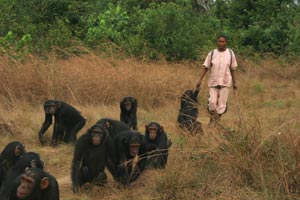| 3. Why are sanctuaries an invaluabe resource for studying non-human apes?
 The Aging Lab Problem The Aging Lab Problem
Largely due to expense, most great ape laboratories outside the United States have been closed. For most researchers laboratory expenses and administrative requirements have proven insurmountable. For example, the high cost of improving aging facilities for innovative long or short term projects that do not focus on human health is prohibitive.
Remaining U.S. centers only house chimpanzees with no possibility for comparisons between ape species. The three commonly recognized chimpanzee subspecies have not been maintained as separate populations so that subspecies comparisons are not possible. Laboratory populations consist almost entirely of adults and are quickly aging due to a ban on breeding since 1997 in facilities receiving U.S. federal funding.
The majority of chimpanzees in laboratories were reared and live in environments that do not resemble those where wild populations live and evolved . Most live in simple concrete cages using the decades old design of Robert Yerkes – a design produced before any studies of wild chimpanzees had been conducted.
Sanctuaries for Solutions
There are 17 sanctuaries in 12 countries each with populations ranging from 20-120 apes. Sanctuaries manage apes at a fraction of the cost of laboratories. This means relatively small grants for all types of non-invasive work can accomplish a lot. Thus, innovation is aided since, for example, it is easy to remodel workspace for short or long term projects.
All ape species (including the largest population of captive bonobos in the world – with over 40 individuals!) are represented in sanctuaries. Subspecies as a rule are maintained as separate populations so that all three chimpanzee subspecies can be compared. While breeding is controled, the majority of individuals in sanctuaries are infants and juveniles.
Day enclosures for large social groups offer apes large tracks of tropical forest that can be as large as 40 hectares (100 acres). This means apes you will study are reared and live in environments highly similar to those for which apes evolved to thrive mentally and physically. Thus, the housing standards arguably exceed anything that exist outside of Africa.
|

